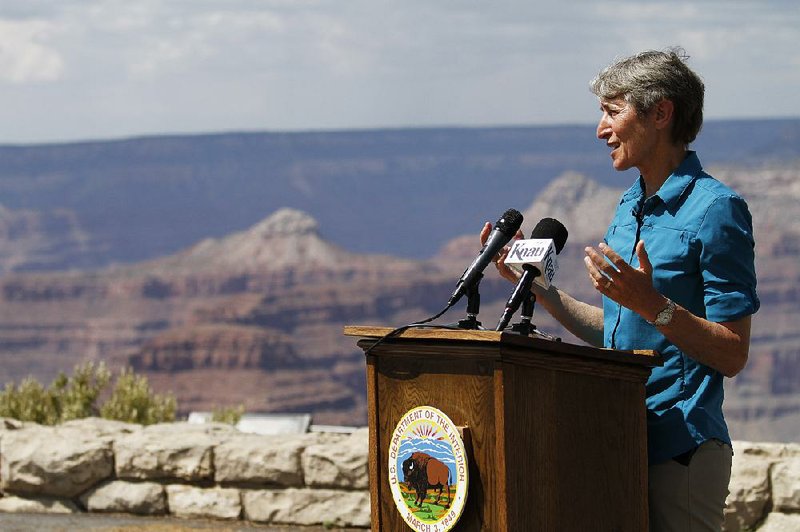When dusk falls tonight on Yellowstone National Park, Interior Secretary Sally Jewell is expected to kick off a commemoration of the 100th birthday of the National Park Service that will likely go well into the night.
Six thousand people will gather under the Roosevelt Arch at the park's north entrance to hear federal officials and governors extol the virtues of national parks, hailed as "America's best idea." On Aug. 25, 1916, President Woodrow Wilson signed the act creating the National Park Service, responsible for protecting 35 national parks and monuments. The service's mission has grown to include more than 400 parks on 85 million acres in the 50 states and the territories.
These days the views at the parks aren't all pretty. The system faces a $12 billion maintenance shortfall that's left infrastructure in disrepair. Yellowstone's backlog alone is $603 million with more than a decade's worth of crumbling roads, buildings and wastewater systems.
Another looming challenge lies in who visits the parks. The average age of park visitors is as high as 63 at some sites, and the National Park Service is unsure how to entice younger people away from cities and the Internet.
Climate change is making matters worse. Rising temperatures and sea levels are grinding away at the Assateague Island National Seashore and decreasing snow and rain, stunting the growth of vegetation in several parks, including the Grand Canyon and the Mojave Desert, leaving bighorn sheep with little to eat. At Glacier National Park in Montana, rising temperatures have reduced the size of the most accessible glacier in North America at Mount Grinnell.
This year is projected to be a banner year for the park system, with attendance topping 330 million for the first time -- an increase of 23 million from last year. The top draws are Great Smoky Mountain National Park in North Carolina and Tennessee with 10 million visitors in 2014, Grand Canyon National Park in Arizona with nearly 5 million visitors, and Yosemite National Park in California with nearly 4 million, according to the park service. Last year, visitors spent more than $16 billion in cities and towns around the parks.
The most stalwart park visitors are disappearing, though, because of aging and death. The question of how to draw more young people and minority-group members who were historically alienated from parks is unsolved. Jewell wants to diversify park visitors and ensure that "the service is relevant to all Americans and engaging the next generation," according to an announcement of today's events.
The splendor of the parks is tough to oversell. Visiting national parks, Americans sometimes find themselves face to face with bison and within shouting distance of bears. They walk across earth charred by lava flows and watch it flow down cliffs into the Pacific Ocean.
There are also pulsing geysers, eye-popping views from cliffs, canyons the size of cities, and rich animal diversity. Many of the millions of people who visit the Washington Monument, St. Louis' Gateway Arch and the Oklahoma City National Memorial are unaware that they're all maintained by the park service.
But more visitors add to the number of people who encounter problems. "Restroom facilities have been closed; trails have not been maintained because there's no money, so visitors can't take hikes," said Theresa Pierno, president and chief executive of the National Parks Conservation Association. "Sometimes campgrounds and services are lacking. ... It's a very serious issue."
A significant group of park visitors is older than 65, and at that age, entrance is free. The bulk of paying visitors are now between 50 and 60, paving the way for a revenue crash from fees when that group passes age 65 in the next decade. The park service desperately needs new visitors as it moves into its new century.
That's where Sangit Chari comes in. As the program manager for the Office of Relevancy, Diversity and Inclusion, her job is to increase the number of black, Hispanic, American Indian and Asian employees. The hope is that they, with the help of a five-year-old recruitment program for more diverse visitation, will become a beacon for members of minority groups.
"The issue we have with our minority employees is our turnover rates mirror our recruitment rates," Chari said, meaning that they lose as many as they recruit. Traditionally, "it's expected that to move up you move from park to park," Chari said, and postings in remote locations may make members of minority groups feel particularly isolated.
"We also have a challenge retaining millennials," Chari said. "Unless we stem our retention issues ... build a more inclusive environment, we will continue to remain stable."
At Yosemite, John Jackson, a park ranger who's black, said he goes out of his way to make members of underrepresented groups feel welcome when they show up at Yosemite.
"If you like reading a book, I tell them you can sit by the river. It could be a good place to take a nap," he said. "I let them know the park is an open space for many different activities. But don't try to do too much. If you have one day or one hour, just do one thing."
A Section on 08/25/2016
